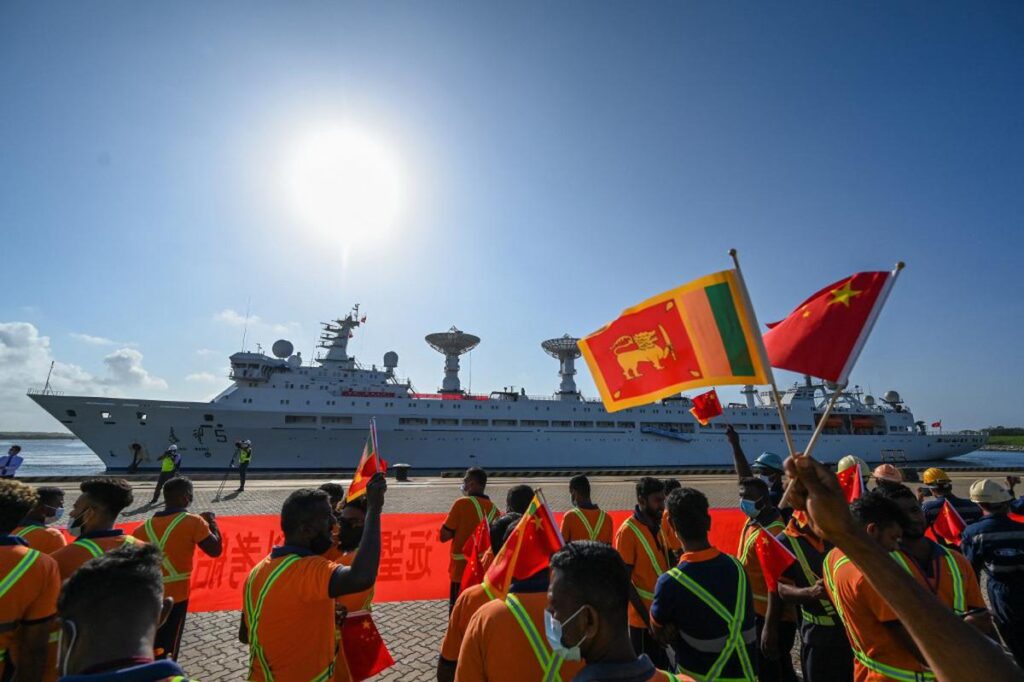Emerging Developments in Marine Research within Sri Lanka's Maritime Domain.
by Yasiru Ranaraja
As we know, the Chinese invented gunpowder in the 9th century, which was later brought to Europe by the Arabs via the Silk Road. Over the years the Europeans mastered the science and physics behind the use of gunpowder, and ways to integrate these technologies with naval operations. As a result, they managed to mount fire cannons on naval vessels and, by the 18th century, western nations arrived in the Indian Ocean and South China Sea. This led to the use of advanced naval firepower and they managed to capture all Chinese naval positions with just two gunboats to in just 48 hours. The following century in China is often referred to as the “Century of Humiliation,” a period not extensively documented in Chinese history books but central to current national and foreign policy motivations.
Meanwhile, the 16th and 17th centuries was a time when naval powers like the Portuguese, Dutch, and later the British began installing cannons on their ships and ventured into the Indian Ocean. At the time Vimaladharmasuriya I of the Kingdom of Kandy faced a crucial geopolitical decision. He needed to balance the power rivalry and acquire naval technologies from these superpowers, recognizing that future wars would be fought with firearms rather than swords. His strategy involved playing the Portuguese against the Dutch, offering the Dutch freehold lands to grow cinnamon in exchange for modern naval technologies. During that time Vimaladharmasuriya traveled to Goa, India with the Portuguese, where he was baptized as Dom João, learned modern fighting techniques from the Portuguese, and gained battle experience. Upon returning to Kandy, he renounced Christianity, embraced Buddhism, and brought the politically significant relic of the tooth of the Buddha to Kandy. He housed the relic in a two-storied Temple of the Tooth near the Royal Palace of Kandy. Later on, Vimaladharmasuriya successfully repulsed two major Portuguese offensives on Kandy, the Battle of Danture in 1594 and the Battle of Balana in 1602, in both of which the Portuguese were humiliatingly defeated.
However, this strategy faltered due to personal conflicts between the King of Kandy and the Dutch. Had this strategy been effectively implemented, naval technologies would have been transferred to Asian countries by the Kingdom of Kandy, and the Portuguese might not have been as powerful, potentially altering the control of strategic locations like the Malacca Strait and Macau in China. The point here is to explore how history is shaped when new advanced technologies arrive.
The Next Hundred Years of the Indian Ocean.
The next hundred years of naval technologies will not be the same as the last century, and some can argue that the Sri Lanka’s recent decision to ban foreign maritime research vessels into its waters has led to significant implications for the growth of the country’s marine research capabilities also an increasing interest in marine research in Sri Lankan waters.This move has forced China’s research vessel Xiang Yang Hong 03 to seek replenishment facilities in the Maldives instead of Sri Lanka, highlighting China’s strategic flexibility and Sri Lanka’s loss of valuable research opportunities. Despite possessing extensive territorial waters and a vast Exclusive Economic Zone (EEZ), Sri Lanka has historically underinvested in marine research and lacks the necessary infrastructure and expertise to explore and utilize its maritime resources effectively.
One of the main reasons for the ongoing research vessel ban is due to the geopolitical tensions surrounding Chinese research vessels labeled as “spy ships” exacerbating diplomatic strains with key regional players, complicating Sri Lanka’s foreign policy landscape. Sri Lanka’s challenge is to strike a balance by enhancing domestic research capabilities while nurturing international scientific collaboration. This dual approach is essential for fully harnessing its marine potential and effectively managing the intricate geopolitical landscape of the Indian Ocean region. Moreover, it should actively pursue opportunities to collaborate with the world’s foremost maritime research organizations without compromising its research initiatives.
In 2010’s, Sri Lanka faced a geopolitical crisis initiated by substantial Chinese investments, notably the investment of deep terminal in Colombo Port and Chinese submarine deployment, Hambantota Port and debt trap saga, and currently, the presence of Chinese research vessels in its territorial waters. These developments have raised concerns from regional powers such as India, about Chinese naval expansion in the Indian Ocean. In response, Sri Lanka has begun a strategic realignment, seeking alternative partnerships to enhance maritime security. Collaborative efforts with key allies such as the U.S., Japan, and France are focused on improving maritime capabilities, strengthening security, and advancing strategic interests. This shift has also allowed Sri Lanka to reframe Chinese investments, such as the Colombo Port City project, Hambantota International Port as a global initiative rather than solely China-backed ventures.
It’s no secret that Sri Lanka’s strategic position at the crossroads of major shipping lanes in the Indian Ocean plays a crucial role in global maritime trade. Recent challenges, including managing the presence of Chinese research vessels in its waters, have highlighted the urgency for Sri Lanka to strengthen its maritime security.
In response, the country has adopted a proactive approach, forming strategic partnerships with key allies like the United States, Japan, and France, while also developing a 2030 Naval Strategy and drafting new policies as ‘Standard Operating Procedures’ for incoming research vessels. These collaborations are aimed at safeguarding Sri Lanka’s territorial waters and asserting its sovereignty and strategic autonomy.
The United States has emerged as a pivotal partner, providing Sri Lanka with essential training and operational support to enhance its maritime security capabilities. Through initiatives such as deploying ISR aircraft like the Challenger 605, Sri Lanka gains advanced surveillance capabilities critical for maritime operations. This aircraft, similar to Boeing’s Maritime Surveillance Aircraft (MSA) initiative, enables Sri Lanka to conduct surface searches, track vessels, detect submarines, collect electronic intelligence, and conduct search and rescue missions effectively. France engages in strategic dialogue with Sri Lanka, focusing on information-sharing and capacity-building in maritime security. French assistance has contributed significantly to improving Sri Lanka’s ability to monitor and respond to maritime incidents, such as the detection and containment of oil spills using satellite imagery technology.
Japan’s collaboration with Sri Lanka emphasizes marine research and infrastructure development, particularly in ports crucial to regional trade. Japanese investments in Sri Lanka’s ports, including Trincomalee and Colombo, underscore their strategic interest in enhancing maritime infrastructure and security in the region. China is already a major maritime power and Chinese Marine Scientific Research vessels often visit Sri Lankan waters for joint surveys under different MoUs and cooperation agreements with Sri Lankan local institutes, yet this was a huge pressure for the Sri Lankan government from India, the U.S., and the other missions in Colombo. As a solution, the Sri Lankan government turned to Japan in this regard and as a measure to attain this situation the Japanese Government agreed to offer Sri Lanka a vessel equipped for underwater surveys, which would aid in capacity-building to conduct hydrographic research and chart Sri Lanka’s maritime domain, the vessel is equipped with sonar to be used for compiling maritime charts. Japanese foreign minister told the Sri Lankan leaders publicly that Japan intends to further strengthen cooperation with Sri Lanka in the maritime domain to realize a ‘free and open’ Indo-Pacific.
Sri Lanka’s partnerships with these nations represent critical steps towards strengthening its maritime security posture amidst increasing regional challenges and opportunities. These alliances not only enhance Sri Lanka’s operational capabilities but also reinforce its position as a key player in the Indian Ocean’s maritime domain. Sri Lanka’s strategic collaborations diversifying partnerships and leveraging the expertise of key allies seeks not only to strengthen its maritime capabilities, safeguard territorial waters, but also to uphold regional stability in the Indian Ocean.
Sri Lanka 2030 Naval Strategy.
A strong naval operational force is important for Sri Lanka to maintain order and security in Sri Lankan waters. As per the proposal of current president Ranil Wickremasinghe, a new 2030 Naval Strategy for Sri Lanka is drafting with dedication to enhancing Naval capabilities, modernizing the Naval fleet, and fostering strategic partnerships with maritime stakeholders and other nations, in focusing on maritime diplomacy, humanitarian assistance, and disaster relief efforts.
Despite traditional threats, the Sri Lanka Navy identifies to stand before growing National Traffic Systems not only in the interest of Sri Lanka but also in the interest of regional and international partners in the maritime domain. However, all these will line up in Sri Lanka’s national policy including foreign policy and national security policy. The threats and challenges in the maritime domain also move fast compared to the last decade. Developing an ‘2030 Naval Strategy’ with forecasted analysis of future challenges, and securing the trade points to lay blueprints to get equipped to address such potentials in the future could be the main strategic advantage of drafting this 2030 strategy.
Given the impacts of climate change on Sri Lanka’s maritime domain, Humanitarian Assistance and Disaster Response (HADR) could be an area of focus in the future, and it’s important to consider the utilization and safeguarding of sovereign seabed resources, as well as the country’s ambitions in the blue economy. The main important nations that Sri Lanka considers cooperating with improving the naval capabilities of Sri Lanka include Australia, China, U.S. Japan, Russia, Iran, India, and France.
Looking forward, Sri Lanka needs to accrue new advance versions of technologies as the Coastal Radar Systems, Satellite-based AIS (Automatic Identification System), and Unmanned Aerial Vehicles (UAVs) to monitor the Exclusive Economic Zone (EEZ) of Sri Lanka. Also, Unmanned Surface Vehicles (USVs) and Unmanned Underwater Vehicles (UUVs), like UAVs, provide affordable alternatives for conducting patrols and collecting intelligence.
China with a growing maritime domain and fast-growing advanced technologies in such areas can play a crucial role in developing the Sri Lanka Navy’s capabilities. A few years back, China granted the Sri Lanka Navy and Advanced Offshore Patrol Vessel (AOPV), which was commissioned as “SLNS Parakramabahu”. However, the platforms provided by China and other countries have not significantly enhanced the Sri Lanka Navy’s operational capabilities. For instance, the SLNS Parakramabahu was a frigate in the People’s Liberation Army Navy (PLA Navy) but was converted into an Offshore Patrol Vessel before being transferred to the Sri Lanka Navy.
Looking at the regional naval advancements, the Sri Lanka Navy should look forward to improving its capabilities in areas such as anti-submarine warfare, electronic warfare, and surface warfare, including surveillance, anti-missile defense, and intelligence, surveillance, and reconnaissance (ISR). These capabilities are basic requirements for modern navies. Many surface vessels now feature AI-powered systems for better decision-making, which are essential for classic naval roles beyond combat.
Sri Lanka’s Legal Claim for an Extended Marine Territory.
Sri Lanka is a signatory to the United Nations Convention on the Law of the Sea (UNCLOS) and ratified it in 1994 and has established its territorial sea, which extends up to 12 nautical miles, and its contiguous zone, which extends up to 24 nautical miles. Additionally, it has established its Exclusive Economic Zone (EEZ), which extends up to 200 nautical miles, and recognizes the Palk Strait, and a portion of the Gulf of Mannar as its “historic waters”, which are considered to be a part of its internal waters and territorial sea.
Under Article 76 of the convention and Annex II, the UNCLOS established criteria for determining the maritime jurisdiction of coastal states. Article 76 serves as the foundation for delineating maritime boundaries, defining a coastal state’s “continental shelf” to include the seabed and subsoil extending beyond its territorial sea, following the natural extension of its land territory to the outer edge of the continental margin, which comprises the submerged extension of the continental shelf. Measurement for determining these boundaries begins from a baseline, defined as the low-water line used for surveying.
The Paragraph 4(a) of Article 76 provides formulas for determining the outer limits of the continental margin. The first, known as the sediment or Irish formula, permits a state to claim adjacent sea areas up to a boundary where oceanic sediments reach 1% of the distance from the foot of the slope, not exceeding 350 nautical miles from the baseline. The second formula, the Hedberg formula, named after geologist Hollis Hedberg, allows claims up to 60 nautical miles from the foot of the continental slope, not exceeding 100 nautical miles from the 2500-meter isobath.
Determining these boundaries involves geological and geophysical studies such as single-channel seismic work by institutions in the USA, Germany, and Russia, the Deep-Sea Drilling Project (DSDP), and satellite gravity anomaly interpretations by local geophysicists. These studies revealed that Sri Lanka could claim an oceanic area approximately twenty-five times its land area, predominantly in the southern Bay of Bengal, characterized by thick sediment deposits with significant potential for hydrocarbon accumulation.
As per the UNCLOS, Coastal nations can appeal to the United Nations Commission on the Limits of the Continental Shelf (CLCS) arguing that the outer limits of their continental shelves extend beyond 200 nautical miles. This provision, allows Sri Lanka to set its boundary based on a sediment thickness of one kilometer and exempts it from the 350 nautical mile limitation applicable to other states.
In the early part of 2007, the DEOCOM project (Delimitation of the Outer Edge of the Continental Margin of Sri Lanka) project, initiated to fulfil this requirement, faced significant challenges. During President Mahinda Rajapaksa’s regime, he has appointed a High-Level Committee to address these issues, co-chaired by key figures from Sri Lanka’s original Law of the Sea delegation. In 2009 Sri Lanka submitted the technical and geological evidence of this sediment thickness to maintain its claim.
This claim is crucial and falls under national interest given the Indian Ocean’s substantial reserves of oil, gas, and other natural resources yet despite these efforts, doubts persist about whether Sri Lanka has the necessary resources and time to effectively secure its marine territorial claim, also due to lapses of financial and technical resources. However, the proclamation on the continental shelf matter will be tabled at the CLCS in 2025.
The Cobalt-Rich Afanasy Nikitin Seamount lies within Sri Lanka's claimed extended marine territory?
The extended maritime territory claim of Sri Lanka is in the boundary with both India and Bangladesh, and Afanasy Nikitin Seamount, a region said to be rich with cobalt and other resources will fall within Sri Lanka’s claimed nautical boundaries towards further south of current Sri Lankan territorial seas.

In 2010, India initially did not oppose Sri Lanka’s submission to the CLCS. However, by 2022, India changed its stance, arguing that Sri Lanka’s claims could potentially impact India’s interests adversely. India formally requested the commission to refrain from considering or endorsing Sri Lanka’s submission. Concurrently, in 2021, India launched its Deep Ocean Mission aimed at exploring deep-sea resources, committing $500 million over five years to this endeavor. By 2023, the Indian government announced progress under this mission, including the development of a crewed deep-sea mining submersible for exploratory mining of polymetallic nodules from the seabed. In 2024 January, India approached the International Seabed Authority (ISA) an independent international body under the UNCLOS, tasked with regulating economic activities on the seabed, seeking permission to explore the cobalt-rich Afanasy Nikitin Seamount located in the central Indian Ocean by applying for the ISA along with a $500,000 fee, outlining plans for comprehensive geophysical, geological, biological, oceanographic, and environmental studies over 15 years in the proposed area, which spans 3,000 square kilometers which is around 1300 kilometers away from Indian territory. During the evaluation of India’s application, the ISA noted that the Afanasy Nikitin Seamount falls entirely within an area also claimed by another country (presumably Sri Lanka) as part of its continental shelf boundaries and put the Indian application on hold. It’s possible to say that India’s urgency is driven by fears over China’s dominance in the global cobalt supply chain, crucial for electric vehicles and renewable energy technologies and India’s application to the ISA faces challenges if Sri Lankas claim is approved by CLSC as the seamount lies within an area claimed by Sri Lanka.
Throughout history, the arrival of advanced technologies has significantly influenced geopolitical dynamics and power balances. From the introduction of gunpowder and naval technologies in the 9th century to the modern deep-sea exploration missions in the Indian Ocean, the strategic use and acquisition of these technologies have shaped the destinies of nations and their interactions on the global stage. Sri Lanka moving away from cooperation initiatives such as the Sri Lanka – China marine research cooperation to avoid the geopolitical pressure could lose its chances to acquire required technologies, as China is a leader in the international market for materials such as Cobalt which is used in renewable energy industries as electric vehicles (EVs). At the moment, China is leading the world in EV manufacturing and controls 70% of the world’s cobalt and 60% of its lithium and manganese other critical minerals. It’s a good opportunity for Sri Lanka to partner with relevant Chinese counterparts to push Sri Lanka’s claimed extended marine territory and place Sri Lanka as a prominent supplier in the global supply chains of such materials. This ongoing process complicates India’s bid and underscores the broader geopolitical stakes in the region. The increasing focus on maritime research in the Indian Ocean, Sri Lanka’s 2030 Naval Strategy, and the Seabed Resources of the Indian Ocean are interconnected in various strategic aspects, deserving priority attention.

Yasiru Ranaraja is a seasoned researcher specializing in maritime affairs and expertise in Belt and Road Initiative (BRI) development. He holds a degree from Dalian Maritime University and earned his LL.M from Ocean University of China in 2019. Yasiru co-founded Belt & Road Initiative Sri Lanka (BRISL), an international development organization based in Sri Lanka, where he currently serves as the founding director. For inquiries, reach out via email at yasiru.ranaraja@gmail.com or connect on Twitter: @YRanaraja


